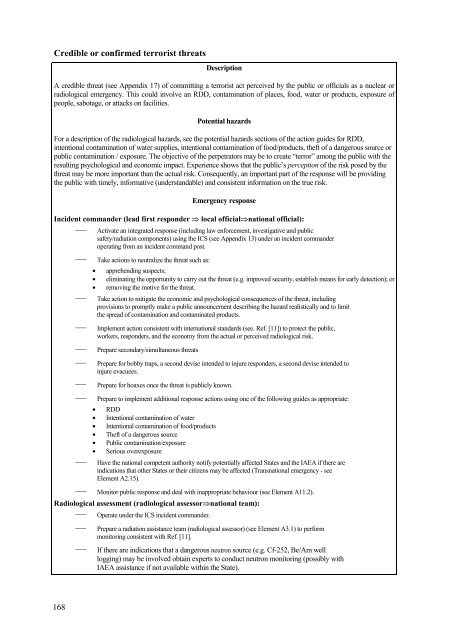epr-method (2003) - IAEA Publications - International Atomic Energy ...
epr-method (2003) - IAEA Publications - International Atomic Energy ...
epr-method (2003) - IAEA Publications - International Atomic Energy ...
Create successful ePaper yourself
Turn your PDF publications into a flip-book with our unique Google optimized e-Paper software.
Credible or confirmed terrorist threats<br />
Description<br />
A credible threat (see Appendix 17) of committing a terrorist act perceived by the public or officials as a nuclear or<br />
radiological emergency. This could involve an RDD, contamination of places, food, water or products, exposure of<br />
people, sabotage, or attacks on facilities.<br />
Potential hazards<br />
For a description of the radiological hazards, see the potential hazards sections of the action guides for RDD,<br />
intentional contamination of water supplies, intentional contamination of food/products, theft of a dangerous source or<br />
public contamination / exposure. The objective of the perpetrators may be to create “terror” among the public with the<br />
resulting psychological and economic impact. Experience shows that the public’s perception of the risk posed by the<br />
threat may be more important than the actual risk. Consequently, an important part of the response will be providing<br />
the public with timely, informative (understandable) and consistent information on the true risk.<br />
Emergency response<br />
Incident commander (lead first responder local officialnational official):<br />
— Activate an integrated response (including law enforcement, investigative and public<br />
safety/radiation components) using the ICS (see Appendix 13) under an incident commander<br />
operating from an incident command post.<br />
— Take actions to neutralize the threat such as:<br />
• apprehending suspects;<br />
• eliminating the opportunity to carry out the threat (e.g. improved security, establish means for early detection); or<br />
• removing the motive for the threat.<br />
— Take action to mitigate the economic and psychological consequences of the threat, including<br />
provisions to promptly make a public announcement describing the hazard realistically and to limit<br />
the spread of contamination and contaminated products.<br />
— Implement action consistent with international standards (see. Ref. [11]) to protect the public,<br />
workers, responders, and the economy from the actual or perceived radiological risk.<br />
— Prepare secondary/simultaneous threats<br />
— Prepare for bobby traps, a second devise intended to injure responders, a second devise intended to<br />
injure evacuees.<br />
— Prepare for hoaxes once the threat is publicly known.<br />
— Prepare to implement additional response actions using one of the following guides as appropriate:<br />
• RDD<br />
• Intentional contamination of water<br />
• Intentional contamination of food/products<br />
• Theft of a dangerous source<br />
• Public contamination/exposure<br />
• Serious overexposure<br />
— Have the national competent authority notify potentially affected States and the <strong>IAEA</strong> if there are<br />
indications that other States or their citizens may be affected (Transnational emergency - see<br />
Element A2.15).<br />
— Monitor public response and deal with inappropriate behaviour (see Element A11.2).<br />
Radiological assessment (radiological assessornational team):<br />
— Operate under the ICS incident commander.<br />
— Prepare a radiation assistance team (radiological assessor) (see Element A3.1) to perform<br />
monitoring consistent with Ref. [11].<br />
— If there are indications that a dangerous neutron source (e.g. Cf-252, Be/Am well<br />
logging) may be involved obtain experts to conduct neutron monitoring (possibly with<br />
<strong>IAEA</strong> assistance if not available within the State).<br />
168

















